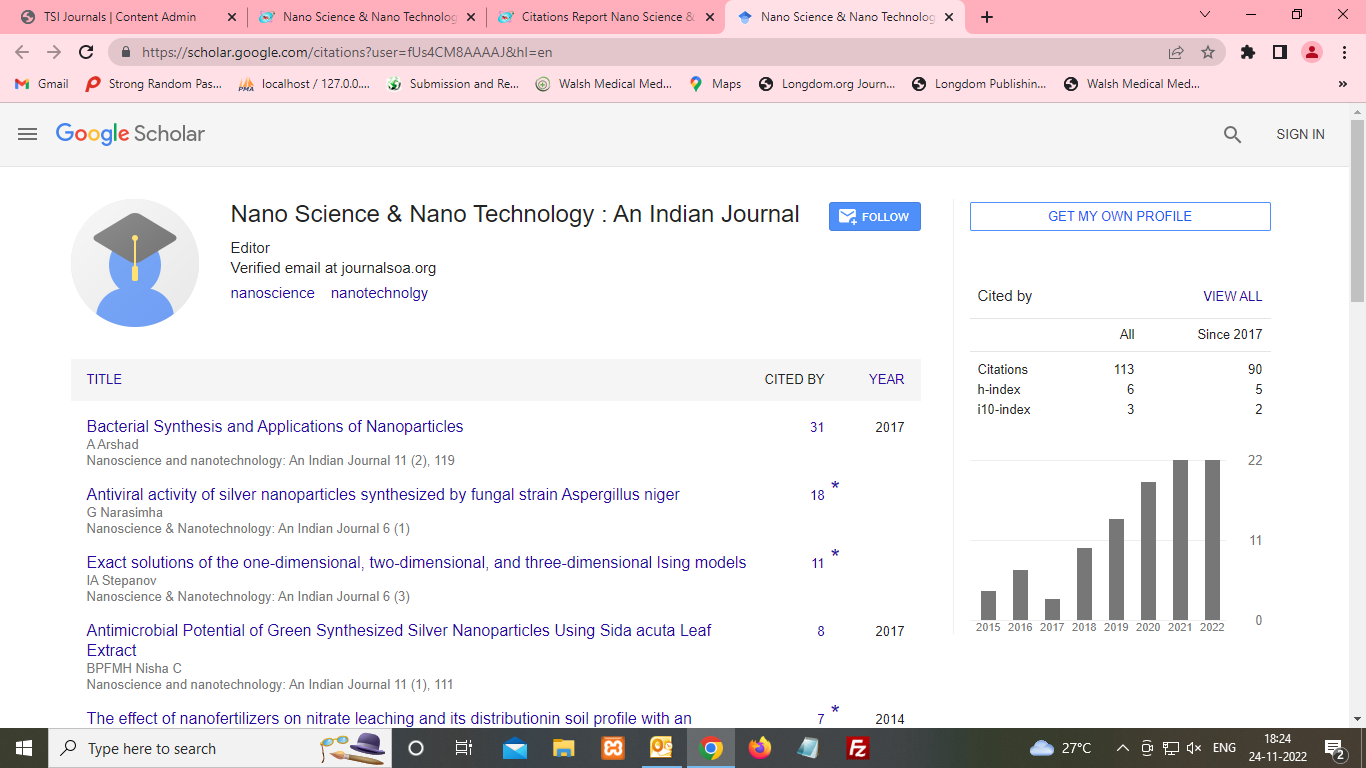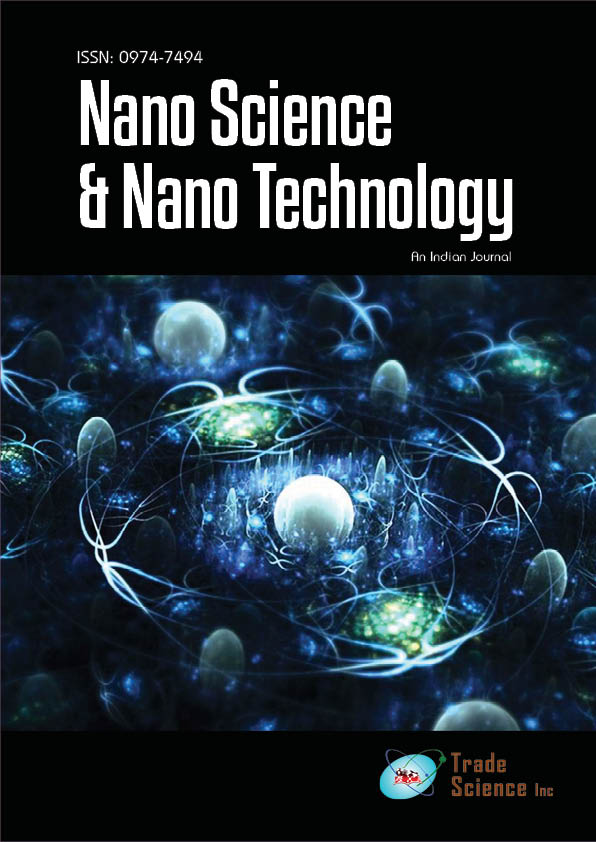Opinion Review
, Volume: 17( 1) DOI: 10.37532/ 0974-7494.2023.17(1).189Nanoencapsulation-The Future era
- *Correspondence:
- Alina CatherineEditorial Office, Nanoscience & Nanotechnology: An Indian Journal, UK ; E-mail: cathalina@gmail.com
Received: March 2, 2023, Manuscript No tsnsnt-23-94999; Editor assigned: March 4, 2023, PreQC No. tsnsnt-23-94999 (PQ); Reviewed: March 16, 2023, QC No tsnsnt-23-94999 (Q); Revised: March 19, 2023, Manuscript No tsnsnt-23-94999 (R); Published: March 30, 2023, doi: 10.37532/ 0974-7494.2023.17(1).189
Citation: Catherine A. Nanoencapsulation-The Future era. Nano Tech Nano Sci Ind J. 2023; 17(1):189.
Abstract
Nanoencapsulation is a process of enclosing or entrapping bioactive compounds or drugs within Nano-sized particles. It is a rapidly developing technology in the field of drug delivery and food science. The purpose of nanoencapsulation is to protect the encapsulated compound from degradation, improve its bioavailability and target specific areas within the body.
Introduction
Nanoencapsulation is a process of enclosing or entrapping bioactive compounds or drugs within Nano-sized particles. It is a rapidly developing technology in the field of drug delivery and food science. The purpose of nanoencapsulation is to protect the encapsulated compound from degradation, improve its bioavailability and target specific areas within the body.
One of the key advantages of nanoencapsulation is that it provides a controlled release of the encapsulated compound. The Nanosized particles can be designed to release their contents at a specific time or in a specific location within the body. This can improve the therapeutic efficacy of drugs and reduce the side effects associated with conventional drug delivery systems.
In addition to drug delivery, nanoencapsulation has also been applied in the food industry to protect bioactive compounds from degradation, increase their solubility, and enhance their sensory properties. For example, nanoencapsulation has been used to deliver vitamins, antioxidants, and flavors in food products.
However, there are also potential drawbacks to Nano encapsulation. The process of nanoencapsulation can be complex and expensive, which can limit its use in some applications. Additionally, there is a concern over the potential toxicity of nanoparticles and their impact on human health and the environment. Further research is needed to fully understand the long-term effects of Nanoencapsulation.
Advantages of nanoencapsulation
Nanoencapsulation offers several positive advantages in drug delivery and food science, including:
1.Improved Bioavailability: Encapsulation in Nano-sized particles increases the surface area of the compound, making it easier to be absorbed by the body. This leads to improved bioavailability of the encapsulated compound.
2.Controlled Release: The encapsulated compound can be released at a controlled rate, providing a sustained and targeted effect. This allows for a reduced dose and minimizes side effects.
3.Protection of Sensitive Compounds: Nanoencapsulation can protect sensitive compounds from degradation, such as oxidation, moisture, and light. This improves the shelf life and stability of the product.
4.Targeted Delivery: Nanoencapsulation allows for targeted delivery of the encapsulated compound to a specific site within the body, such as a tumor or an inflamed area. This reduces the exposure of healthy tissue to the drug and increases the efficacy of the treatment.
5.Enhancement of Sensory Properties: In the food industry, nanoencapsulation can improve the sensory properties of food products, such as the taste and aroma of flavors, while protecting them from degradation during processing and storage.
6.Improved Solubility: Nanoencapsulation can improve the solubility of poorly soluble compounds, such as vitamins and nutraceuticals, increasing their bioavailability and efficacy.
Overall, nanoencapsulation offers several positive advantages that make it a promising technology for drug delivery and food science applications.
Nanoencapsulation in the Future Era
Nanoencapsulation is a rapidly developing technology that holds significant potential for future applications in various fields. Some of the potential future developments of nanoencapsulation include:
Personalized Medicine: Nanoencapsulation technology can be used to deliver personalized medicine, tailored to an individual's specific needs. The ability to target specific sites within the body with precise dosages can improve the effectiveness of treatments and minimize side effects.
Gene Therapy: Nanoencapsulation can be used for the delivery of gene therapy, where genes are encapsulated within nanoparticles and delivered to specific cells in the body. This can provide a targeted and safe approach to gene therapy, which has the potential to treat a wide range of genetic disorders.
Agriculture: Nanoencapsulation can be used in agriculture to improve the efficiency of crop production, by delivering nutrients and pesticides directly to the plant in a targeted manner. This can reduce the number of chemicals used in agriculture, leading to more sustainable farming practices.
Cosmetics: Nanoencapsulation can be used in cosmetics to improve the delivery of active ingredients, such as vitamins, antioxidants, and anti-aging compounds. This can lead to improved efficacy and longer shelf life for cosmetic products.
Energy: Nanoencapsulation can be used to develop new energy storage materials, such as batteries and fuel cells. The increased surface area of nanoparticles can lead to higher energy storage capacities and improved performance.
Overall, nanoencapsulation has the potential to revolutionize many industries and improve the quality of life for people around the world. Further research and development will be necessary to unlock the full potential of this technology, but the future looks bright for nanoencapsulation
Conclusion
In conclusion, nanoencapsulation is a promising technology that has the potential to revolutionize drug delivery and food science. Its ability to provide a controlled release and targeted delivery makes it an attractive option for improving the efficacy and safety of drugs and enhancing the nutritional quality of food products. However, it is important to consider the potential risks and limitations associated with this technology and continue to research its long-term effects.

